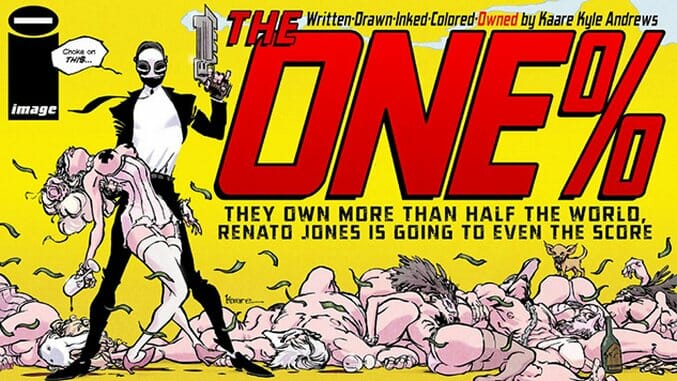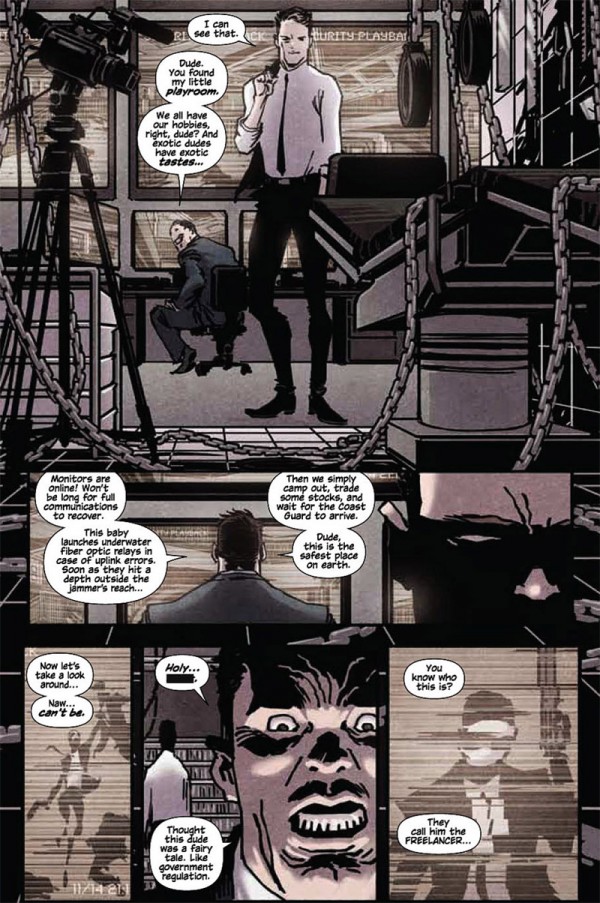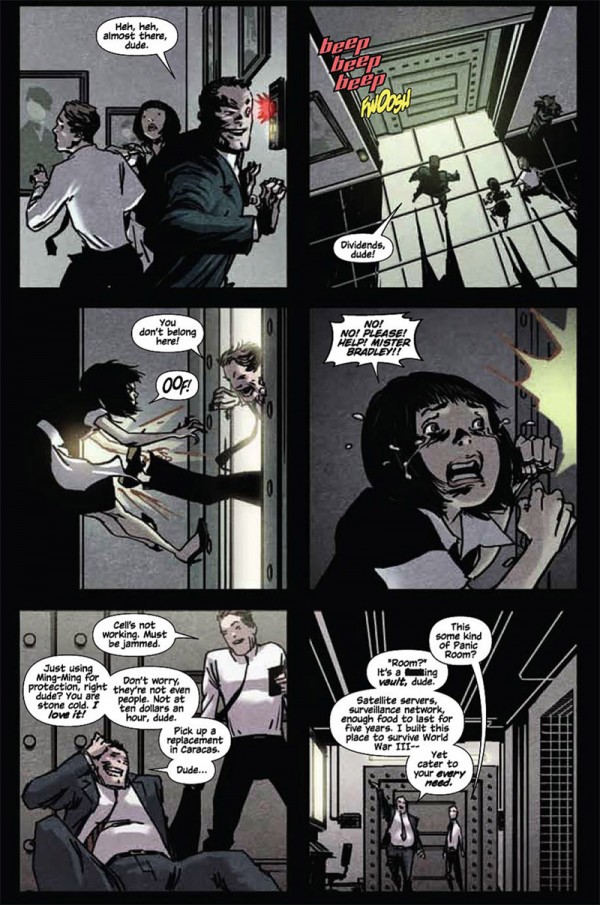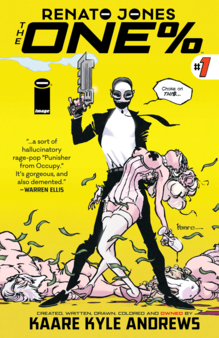Kaare Andrews Massacres the Ultra-Wealthy in the Hyperviolent Comic Satire, Renato Jones: The One%
Comics Features
Renato Jones: The One%, the new series from writer/artist/filmmaker Kaare Kyle Andrews, abounds with plot and atmosphere steeped in socio-political extremity. The title character, a street orphan turned billionaire, stokes the coals of class warfare through Andrews’s gritty, high-contrast artwork. The series’ debut issue merges cartoonish exaggeration, hyper-violence and grindhouse hyperbole (including faux creases on the page) for a singular experience. The overarching plot of a vigilante slaying absurdly rich sociopaths is elevated to gonzo political satire through this meticulous eye for detail.
Andrews has tackled mainstream superhero properties ranging from Spider-Man to Iron Fist, and has hopped behind the camera for indie horror gems like Altitude and The ABCs of Death anthology, but this new series may be the creator’s most memorable work to date. Andrews spoke with Paste to discuss everything from the importance of creator-owned work, to how Renato Jones addresses the populist vigilante archetype.![]()
Paste: Comics have a long line of vigilantes who come from affluent backgrounds but emerge as populist champions: Oliver Queen, Bruce Wayne and even Tony Stark all come to mind. When did you first become aware of this as a trope, and as something that you wanted to subvert in this particular series?
Kaare Kyle Andrews: When I was in the middle of working on Iron Fist I did a convention in Hartford and a kid about 10-years-old walked up to my table and asked me a question: “Why can only rich people become heroes?” His eyes were actually teary and it broke my fucking heart.
When I was a kid, my favorite hero was Spider-Man. He was nearly always broke, but always tried to do the right thing. He was smart, funny and always interested in helping others. It wouldn’t be a stretch to say he directly informed my own sense of right and wrong.
Today’s world seems to have forgotten that kind of hero. Instead of celebrating this kind of selflessness, we are more than not celebrating entitled, billionaire snarks. The modern hero’s journey is no longer a person fighting his way out of a bad situation—to do what’s right and become a better person, which is the classic immigrant journey. The current paradigm is that you were born with power and wealth, and your “journey” is to simply come to terms and accept that you are simply better than everyone else. In many ways, this is the new American Dream. And I take direct issue with this.
Paste: Your protagonist’s name, Renato—or “rebirth”—takes on an increased relevance over the course of the first issue. Did you have that layered meaning in mind from the outset?
Andrews: I was invited down to Italy by Italian publisher Panini for a big comic book convention, because of my work on Iron Fist. And one of the people at Panini was named Renato. I’ve always like the sound of that name, but when he told me it meant “rebirth,” I knew right then and there that I would use it. And that name choice then re-informed the character I had already had in mind. It became a central theme for him and the book as well.
I’ve always loved the idea of rebirth. That we work and live in cycles. That we’re born a hundred times and die just as many. After I had this very Italian first name, I needed a classic American last name, and Jones just sort of sounded better than Renato Smith.

Renator Jones: The One% Interior Art by Kaare Andrews
Paste: Though the income inequality and personal dynamics in Renato Jones: The One% feel very realistic, there are also some speculative elements in the climatic fight scene of the first issue. How would you describe the tone of the series?
Andrews: It’s probably best described as an action-adventure with a lot of dark satire. I’m always interested in emotional moments combined with raw action, all heightened to comic book scale. Once you start throwing in the idea of ultra-wealth, it just becomes so ridiculous—in a good way, I’m hoping.
Paste: The cover of the first issue is immediately eye-catching, but it’s also disconcerting, with the protagonist looking menacing and standing over a group of underdressed bodies while holding a gun. Were you looking to provoke a specific reaction, or something more ambiguous, in the reader?
Andrews: This was one of the first images that came to me as I began the real work of creating the book. I wanted something clean, stark and something that stood out amongst the noise. I’ve actually used yellow quite a bit on my covers for some reason—your mind actually perceives yellow as brighter than white, even if it’s not. And set beside a lot of darkly colored books these days, it was as much a strategic decision to stick out as an aesthetic one. The dead bodies, the masquerade ball (sex orgy) represented the kind of repulsive version of wealth and decadence Renato Jones sets himself against.
You can’t look at the image as a literal moment of the series but more of a meta summation of the entire thesis of the book. And I wrote it on the back of the book to be clear. “The super-rich are super-fucked.” It’s fun! But I also think it’s dangerous and satirical at the same time.

Renator Jones: The One% Promo Art by Kaare Andrews
Paste: Stylistically, the book’s first issue moves back and forth between detailed line work in color and a very stark, stylized black-and-white approach. When you’re outlining an issue, do you know from the outset how these transitions will work?
Andrews: What I do is outline the entire story arc. Then outline the issue by the page. But I leave the task of the storytelling to the layouts. I want to explore and tell the story panel by panel. This way, I have a concrete game plan and a lot of freedom to say it first visually. I think when you go the other way—when you write a full script before you draw anything—you are somewhat castrating yourself artistically. Images can become slaves to words, when in the real world the words we say often contradict what we are actually doing, and come afterwards. Being a writer-artist allows me to tell stories visually in a way that would never exist if I was following someone else’s script. It’s how comics were MEANT to be created. It’s how comics were MEANT to be consumed.
I heard a comment before that goes something like, “this or that book was so well written it was basically just one long conversation and you didn’t even notice.” This to me is a failure of the art form. Comics are a visual medium. I may as well say that a song was so well played I didn’t notice the music in it.
My stories are meant to be read with visual and written language—one feeding off of the other. This is the thing that comics can do that no other medium can do. I love playing with this language. Pages, panels, sound effects, they all become part of what you do. “The medium is the message,” as was coined up here in Canada.
Paste: The book’s cover stresses your “Owned by” credit, and there’s a revenge-seeking vigilante known as “The Freelancer” inside it. Is this series somewhat inspired by your frustration with work-for-hire done for various publishers?
Andrews: Ha! Not intentionally anyways. I’ve been a freelancer for a decade and a half and it’s something we don’t talk a lot about in comics. But I don’t work for Marvel or DC or anyone else. I never have. I’ve worked WITH these big companies but I don’t get vacation pay or benefits or overtime… I’ve worked for myself the entire time. It’s the world I know. And strangely, the current work force of America is catching up. Last I heard, over half of the new jobs out there are freelance or contract jobs. This can be a way for corporations to save some money but it can also give a lot of power. As a freelancer, you can walk away from any situation, walk into any situation, you’re in control of your life and destiny in a way you never would be as an employee.
It became fun to think of Renato Jones as a self-employed vigilante, as a FREELANCER. I may be poking some fun at corporations in future issues here or there, but there really isn’t any kind of message behind it other than self-empowerment. And what better way for a freelancer to become self-empowered than to own his own work? Image is one of the only places this is possible.

Renator Jones: The One% Interior Art by Kaare Andrews
Paste: Your first film as a director (Altitude) was released in 2010. Has working as a filmmaker changed how you think of narrative storytelling across different media?
Andrews: Working across different mediums has simply reinforced my own belief that there is a core to stories and storytelling, to art making, that travels from one medium to the next. In comics, it’s actually quite common for creators to disparage their own efforts, that comics are “easier.” This is utter bullshit of course. If you’re making a living creating comics, they probably do seem easier because you’re already doing it. Like asking Beyoncé if singing is easier than playing tennis. I’m sure Venus Williams would have a very different answer.
The biggest difference is the money. There aren’t billions of dollars at stake in comics the way there can be in film. It keeps the leeches away for the most part. It helps keep the art form pure, in a way that could never happen if the financial stakes were higher. It’s no coincidence that the best films around are coming from comics—where else do you have this pure form of expression to draw from?
Paste: Do you find that your film work has affected what you look to get out of creating comics these days?
Andrews: It must have but I can no longer see it. Do not ask a fish about water. A fish knows nothing about water.
Paste: Were there any storytelling techniques that you’ve found that you had to push yourself on in terms of creating Renato Jones: The One%?
Andrews: I’m always trying to push myself. The biggest battle for Renato Jones was deciding what that first issue would be. How much to show, how much to leave for future issues. Because when you are doing a creator-owned book, you don’t generally have a built-in audience with the patience to make it to even issue two! In many ways, it’s like a pilot for a TV show. You have to either put it all out on the table to show what the series will be, or you need to ask a big enough question that people will need to return to for answers. I ended up choosing the first option, treating my first issue as a James Bond-style prologue that both kicks off the larger plot, but in many ways felt self-contained. Check it out for yourself and let me know if I’ve succeeded!
